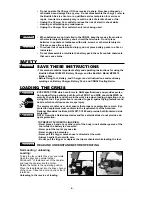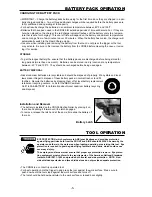
-9-
CLEANING THE CORDLESS NAILER
Do not use gasoline or similar highly flammable liquids to clean
the nailer. Vapor could be ignited by a spark causing an explosion.
For best operation clean system as follows:
Tar and dirt may build up on the nose, driver, and feed system. This
can prevent correct operation. Remove any buildup with kerosene,
#2 fuel oil or diesel fuel. Do not dunk the nailer into these solvents
beyond the height of the nail heads. Dry off the nailer before use.
Any oil film left after cleanup will accelerate the tar buildup, and the
nailer will require more frequent re-cleaning.
NOTE: Solvents sprayed on the nose driver and feed system
may have the opposite effect! The solvent may soften the tar on
the shingles and cause tar buildup to be accelerated. Dry
operation is better, as noted above.
Cleaning of tar from nose assembly and driver
Depress nose release button, and pull nose from tool.
Nose can be wiped down, or immersed in cleaning solvent. Clean the end
of the driver as well as the nose assembly. The driver guide may need
to be removed from the nose in order to clean it properly. Do not immerse
tool in cleaning solvents. Instead, apply a light coat of oil to the nail feed
roller. Tool exterior can be wiped down with cleaning solvents. Once clean
insert nose assembly into tool. Make sure D shaped driver is properly
aligned to nose. Push nose into tool until it locks in place. Review
the nose control switch and verify that it cycles correctly.
MAINTAINING THE CORDLESS TOOL
When working on cordless tools, note the warnings in this manual
and use extra care evaluating problem tools.
Replacing motor brushes:
Remove screws from either side of brush cover and pull brush cover down
to remove it from the motor area of the tool. Remove the brush retaining
springs from the motor. Remove the quick disconnects from the control
module, remove the brush retaining springs, and remove the brushes.
Be careful when removing brush springs as they may fly off and become
lost or stuck in motor.
Installation is the reverse of removal.
REPLACEMENT PARTS:
STANLEY-BOSTITCH replacement parts are recommended. Do not use modified parts or parts which
will not give equivalent performance to the original equipment.
PROCEDURE FOR SEALS:
When repairing a tool, make sure the internal parts are clean and lubricated. Use Parker “O”-LUBE or
equivalent on all o-rings. Coat each o-ring with “O”-LUBE before assembling.
Lubricating the o-rings is recommended on a yearly basis for a normally used tool. Heavy usage may
warrant more frequent greasing intervals. See your authorized Bostitch dealer or service center for
o-ring service information.
clean here
nose release button
Cover removal direction




























